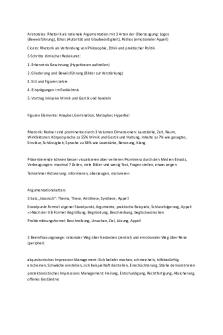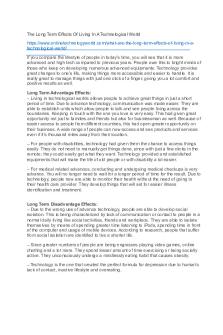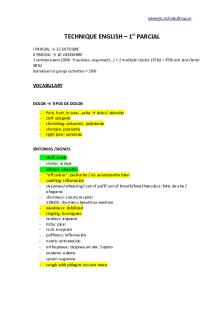Communicative English of BBA 1st semester PDF

| Title | Communicative English of BBA 1st semester |
|---|---|
| Author | Rishiraj Arya |
| Course | good course |
| Institution | DIT University |
| Pages | 3 |
| File Size | 218.1 KB |
| File Type | |
| Total Downloads | 9 |
| Total Views | 144 |
Summary
self notes for easy preparation of examination, best for all the students of bachelor of business management of semester I and also for study about communication...
Description
COMMUNICATION COMMUNICATION: Communication is the activity or process of sharing or exchanging ideas, feelings, information, experience between two or more persons.
The English word ‘communication’ has been derived from the Latin word, ‘Communicare’ which means to impart or participate or to transmit. The word ‘Communicare’ is derived from the root ‘Communis’ which means to make common or to share.
Definitions of communication: 1) The Oxford English Dictionary defines communication as “the action of conveying or exchanging information and ideas.” 2) Peter Little defines communication as “the process by which information is transmitted between individuals and or organizations so that an understanding response results.”
Types of communication: -
VERBAL COMMUNIACTION: Verbal communication is communication transmitted with the use of words. Oral Communication: Oral communication is communication by means of spoken words. Advantages: 1. Its direct & time saving 2. It saves money 3. It conveys the exact meaning of words 4. It provides immediate feedback 5. It is more persuasive in nature 6. On-the-spot additions, deletions and corrections are possible 7. Confidential messages can be communicated 8. It is informal and friendlier 9. Develop relations 10.Motivates the speaker.
Written communication: Written communication is the expression of language by means of visible signs. Advantages 1. Reference 2. Permanent record 3. Legal validity 4. Aids memory & retention 5. Accurate & organized 6. Fixing responsibility 7. Wider reach 8. Goodwill 9. Less chances of misunderstanding 10.Suitable for lengthy messages 11.Corporate image
NON-VERBAL COMMUNICATION: Verbal communication is communication transmitted without the use of words. Sign language: - sign language consists of visual sign or audio sign. a. Visual sign: - facial expression, gestures, printed pictures, road signs, traffic signals all fall under visual sign. b. Audio sign: -audio signs are addressed to our sense of hearing.
Steps and process
The process of communication involves a series of stages: 1) An idea arises in the mind of the sender, which he wants to share. 2) The sender encodes the idea in the form of a ‘message’. 3) The sender chooses some medium / channel to put across the message. 4) The receiver receives the message. 5) The receiver decodes – absorbs, understands, interprets the message. 6) The receiver sends feedback or his response.
Objectives of communication: 1. 2. 3. 4. 5. 6. 7. 8.
Information Advice and counselling Order and instructions Suggestions Persuasion Education and training Motivation Raising the moral of employees
GENERAL PRINCIPAL OF EFFECTIVE COMMUNICATION: -...
Similar Free PDFs

BBA 1st Semester Syllabus
- 12 Pages

ME BBA 1ST - Ssss
- 1 Pages

BBA 2nd Semester Syllabus
- 14 Pages

Rhetorik, BBA, 3. Semester
- 2 Pages

3 Semester Plan Finance BBA
- 5 Pages

Communicative
- 20 Pages

Elements of Maltese Law 1st Semester
- 14 Pages

English 1st parcial
- 10 Pages

I SEM BBA Additional English
- 48 Pages

PEDH 1 20 1st SEMESTER
- 1 Pages

1st semester reaction review KEY
- 2 Pages
Popular Institutions
- Tinajero National High School - Annex
- Politeknik Caltex Riau
- Yokohama City University
- SGT University
- University of Al-Qadisiyah
- Divine Word College of Vigan
- Techniek College Rotterdam
- Universidade de Santiago
- Universiti Teknologi MARA Cawangan Johor Kampus Pasir Gudang
- Poltekkes Kemenkes Yogyakarta
- Baguio City National High School
- Colegio san marcos
- preparatoria uno
- Centro de Bachillerato Tecnológico Industrial y de Servicios No. 107
- Dalian Maritime University
- Quang Trung Secondary School
- Colegio Tecnológico en Informática
- Corporación Regional de Educación Superior
- Grupo CEDVA
- Dar Al Uloom University
- Centro de Estudios Preuniversitarios de la Universidad Nacional de Ingeniería
- 上智大学
- Aakash International School, Nuna Majara
- San Felipe Neri Catholic School
- Kang Chiao International School - New Taipei City
- Misamis Occidental National High School
- Institución Educativa Escuela Normal Juan Ladrilleros
- Kolehiyo ng Pantukan
- Batanes State College
- Instituto Continental
- Sekolah Menengah Kejuruan Kesehatan Kaltara (Tarakan)
- Colegio de La Inmaculada Concepcion - Cebu




